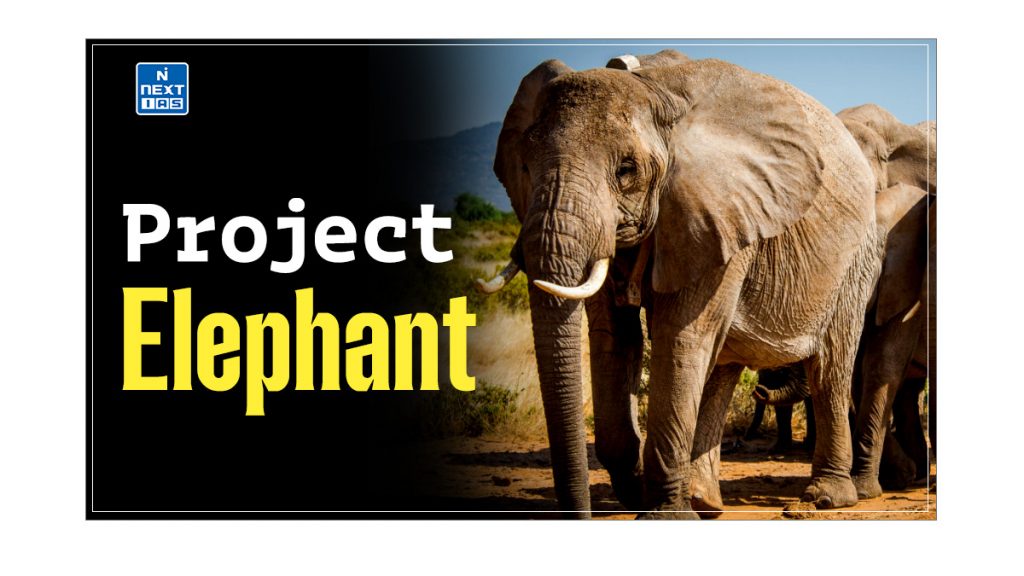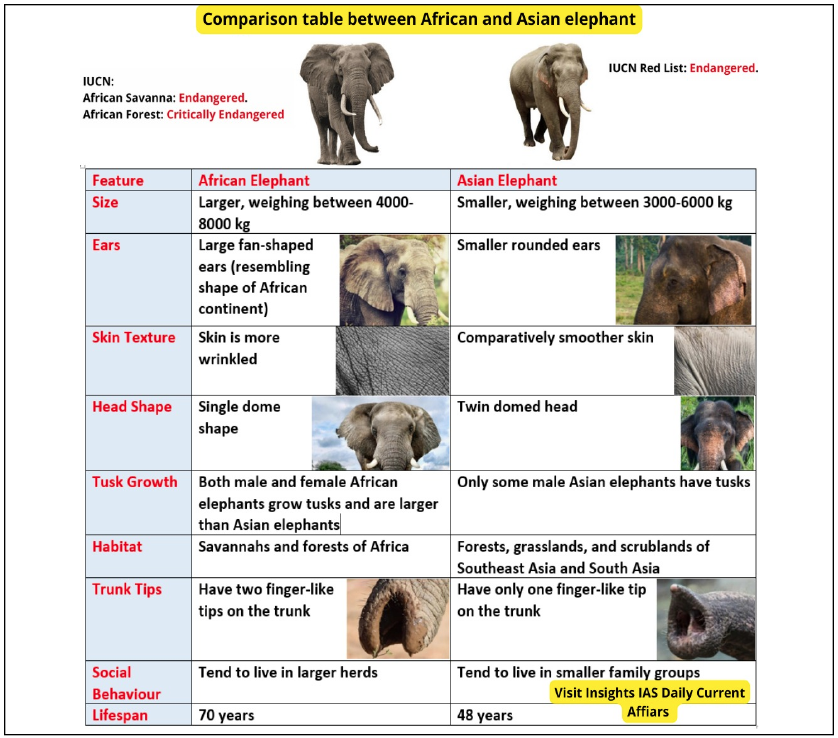
Project Elephant is a conservation initiative launched by the Government of India in 1992 to protect elephants and their habitats. This project is crucial for mitigating human-elephant conflicts and ensuring the survival of elephant populations in the wild. This article aims to study in detail the objectives, strategies, achievements, and ongoing challenges of Project Elephant.
About Project Elephant in India
- Project Elephant, launched by the Government of India in 1992, is a significant conservation initiative to protect the country’s elephant population and habitats.
- The project focuses on safeguarding these majestic animals from threats such as poaching and habitat destruction while also working to mitigate conflicts between elephants and local communities.
- By establishing and managing protected areas and wildlife corridors, Project Elephant ensures that elephants have safe and sustainable environments in which to thrive.
- The initiative promotes research and monitoring to enhance our understanding of elephant behaviour, health, and population dynamics.
Objectives of Project Elephant
The primary objectives of Project Elephant are:
- To assist States in having wild elephant populations and ensuring the long-term survival of identified viable elephant populations in their natural habitats.
- To address man-animal conflict.
- To develop scientific and planned management measures for the conservation of elephants.
- To protect the elephants from poachers, preventing illegal ivory trade and other unnatural causes of death.

Elephant Corridor
- An elephant corridor is a stretch or narrow strip of forested (or otherwise) land that connects more significant habitats with elephant populations and forms a conduit for animal movement between them.
- This movement helps enhance species’ survival and birth rate.
- According to the Elephant Corridors of India 2023 report, there are 150 identified Elephant Corridors in India.
Threats to Elephant Corridors
The major threats to elephant corridors are:
- Developmental activities such as constructing buildings, roads, railways, holiday resorts, and fixing solar-energised electric fencing cause habitat loss, leading to fragmentation and destruction.
- Coal and iron ore mining are the two “single biggest threats” to elephant corridors in central India.
- Orissa, Jharkhand, and Chhattisgarh are mineral-rich states, but they also have the highest number of elephant corridors in the country, which makes them known for elephant-man conflicts.
- There is also a severe poaching problem, as elephant ivory from the tusks is extremely valuable.
- Elephants need extensive grazing grounds, and most reserves cannot accommodate them.
- If protected areas are not large enough, elephants may search for food elsewhere. This often results in conflicts with humans because elephants raid or destroy crops.
Strategies for Mitigation and Corridor Protection
- Fusion of the corridors with nearby protected areas wherever feasible; in other cases, declaration as Ecologically Sensitive Areas or conservation reserves to grant protection.
- During the process of securing a corridor, monitoring for animal movement has to be carried out; depending on the need, habitat restoration work shall also be done.
- Securing the corridors involves sensitising local communities to the option of voluntarily relocation outside the conflict zones to safer areas.
- Preventing further fragmentation of the continuous forest habitat by encroachment from urban areas.
Initiatives for Protecting Elephants
Several initiatives have been undertaken by the Government of India to protect the habitat of elephants:
Monitoring of Illegal Killing of Elephants (MIKE) Programme
This programme is mandated by the COP resolution of CITES; the MIKE program started in South Asia in 2003 to provide the information needed for elephant range States to make appropriate management and enforcement decisions and to build institutional capacity within the range States for the long-term management of their elephant populations.
Haathi Mere Saathi Campaign
- It is a campaign launched by the Ministry of Environment and Forest (MoEF) in partnership with the Wildlife Trust of India (WTI).
- The campaign was launched at the “Elephant-8” Ministerial meeting in Delhi in 2011.
- The E-8 countries comprise India, Botswana, the Republic of Congo, Indonesia, Kenya, Sri Lanka, Tanzania, and Thailand—this public initiative aimed to increase awareness among people and develop friendship and companionship between people and elephants.
Project RE-HAB in Assam
- After the success of the innovative Project RE-HAB (Reducing Elephant-Human Attacks using Bees) in Karnataka, the Khadi and Village Industries Commission (KVIC) has replicated the project in Assam.
- Project RE-HAB was launched on 15 March 2021 at 11 locations in the Kodagu district of Karnataka. In just six months, it reduced elephant attacks by over 70%.
- Under Project RE-HAB, “Bee-fences” are created by setting up bee boxes in elephants’ passageways to block their entrance to human territories.
- The boxes are connected with a string so that when elephants attempt to pass through, a tug or pull causes the bees to swarm the elephant herds and dissuade them from progressing further.
- It is a cost-effective way of reducing human-wild conflicts without causing any harm to the animals. It is scientifically recorded that elephants are annoyed by the honey bees.
- Elephants also fear that bee swarms can bite the sensitive inner side of the trunk and eyes. The collective buzz of the bees is annoying to elephants and forces them to return.
Elephant Reserves in India
- Elephant Reserves in India are designated areas to conserve the Asian elephant and its habitat.
- Established under the Project Elephant initiative launched in 1992, these elephant reserves in India focus on protecting elephants from poaching and habitat loss while promoting coexistence with local communities.
- India is home to approximately 60% of the world’s Asian elephant population, and notable reserves like the Periyar Wildlife Sanctuary in Kerala and Kaziranga National Park in Assam are located there.
- These elephant reserves in India play a crucial role in maintaining biodiversity, supporting ecological balance, and ensuring the survival of this majestic species.
Conclusion
Project Elephant underscores India’s dedication to conserving its elephant population and habitats. The project has achieved notable successes by tackling habitat loss, poaching, and human-elephant conflicts. Initiatives like Project RE-HAB and the Haathi Mere Saathi campaign exemplify innovative approaches to fostering coexistence. However, challenges like habitat fragmentation and urban encroachment persist, necessitating ongoing efforts. Project Elephant remains a vital example of effective wildlife conservation, inspiring global efforts to protect biodiversity.
World Elephant Day
World Elephant Day, observed on August 12, is dedicated to raising awareness about the plight of elephants and promoting their conservation. Established in 2012, World Elephant Day highlights the threats faced by African and Asian elephants, including habitat loss, poaching, and human-wildlife conflict. Various organisations and individuals participate in events, educational programs, and fundraising efforts to support elephant protection initiatives and raise awareness about their ecological significance. By fostering a greater understanding of these majestic creatures, World Elephant Day aims to inspire collective action to ensure their survival for future generations.
Frequently Asked Questions (FAQs)
Project Elephant was launched in?
Project Elephant was launched in 1992.
What are Elephant Projects in India?
Major elephant projects in India include:
– Project Elephant – Focused on conserving and protecting elephants and their habitats.
– Elephant Corridors – Initiatives to create safe pathways for elephants to move between habitats.
– State-specific programs – The Kerala Forest Department’s “Elephant Rehabilitation Program” and the “Karnataka Elephant Project” for population monitoring and conflict resolution.






